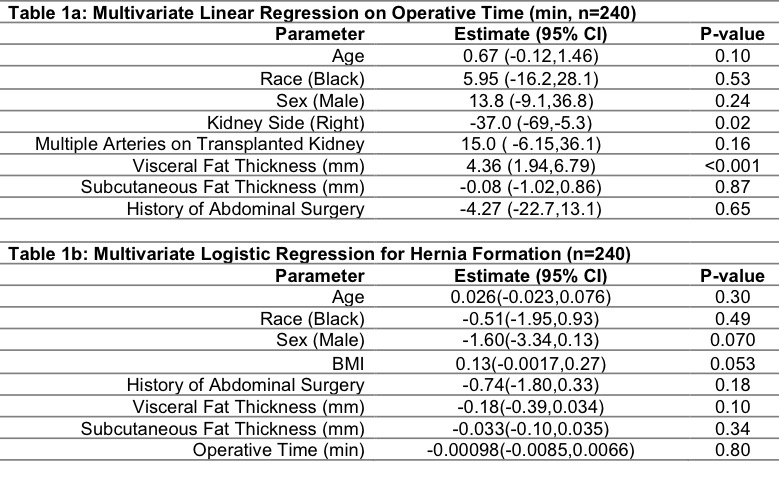Correlates of Surgical Difficulty and Post-Operative Complications in Living Donor Kidney Procurement
1Surgery, Duke University, Durham, NC, 2Radiology, Duke University, Durham, NC, 3Biostatistics, Duke University, Durham, NC
Meeting: 2019 American Transplant Congress
Abstract number: B281
Keywords: Outcome, Radiologic assessment
Session Information
Session Name: Poster Session B: Kidney Living Donor: Selection
Session Type: Poster Session
Date: Sunday, June 2, 2019
Session Time: 6:00pm-7:00pm
 Presentation Time: 6:00pm-7:00pm
Presentation Time: 6:00pm-7:00pm
Location: Hall C & D
*Purpose: Living donor kidney donation is essential for decreasing waitlists for kidney transplantation. Though donor nephrectomy is a standard operation, there is a paucity of data on the factors that may impact surgical technical difficulty as well as post-operative outcomes. In the present study, we define correlates of increased difficulty of operation and post-operative complications in order to better plan for donor nephrectomy.
*Methods: We identified 242 patients who underwent surgery from 2010-2017. Operative times and clinical variables were abstracted from the patient charts. Radiographic variables were determined from original CT scans by our study radiologist. Complications (including readmission for any reason, reoperation, hernia, surgical site infection, deep venous thrombosis, hematoma, and seroma) were abstracted from patient charts and UNOS report data. Key variables and statistics were summarized using means, medians, or frequencies (where appropriate). Multivariate linear and logistic regression models were postulated to test the association between relevant variables of interest and operative time and hernia formation respectively.
*Results: 83 subjects (34%) were male, the median age at time of surgery was 43 years, and 106 (44%) had undergone prior abdominal surgery. Median operative time was 369 minutes (IQR = 322-409) including anesthesia time. Operative time was decreased for right kidney donation (-37.0 [95% CI =-68.8,-5.3 ; p = 0.02]) and increased with increasing thickness of visceral fat (4.36 minute increase for each mm of visceral fat [95% CI = (1.94,6.79); p<0.001]) (Table 1a). 68 subjects (28%) experienced some complication, and 19 (8%) required ventral hernia repair after surgery. In the logistic regression model, BMI (p=0.053) and sex (p=0.070) were borderline significant covariates (Table 1b).
*Conclusions: Operative time in living donor kidney donation is longer when the left kidney is selected (due to longer renal vein), and when there is more visceral fat. Radiologists should consider reporting visceral fat as a measure of technical difficulty for the surgeon. Even in our small cohort, there is some suggestion that there are specific individuals at higher risk for hernia.
To cite this abstract in AMA style:
Shaw BI, Schwartz FR, Vernucci F, Rigiroli F, Gonzalez F, Lerebours R, Rege AS, Vikraman D, Marin D, Ravindra KV. Correlates of Surgical Difficulty and Post-Operative Complications in Living Donor Kidney Procurement [abstract]. Am J Transplant. 2019; 19 (suppl 3). https://atcmeetingabstracts.com/abstract/correlates-of-surgical-difficulty-and-post-operative-complications-in-living-donor-kidney-procurement/. Accessed December 19, 2025.« Back to 2019 American Transplant Congress

